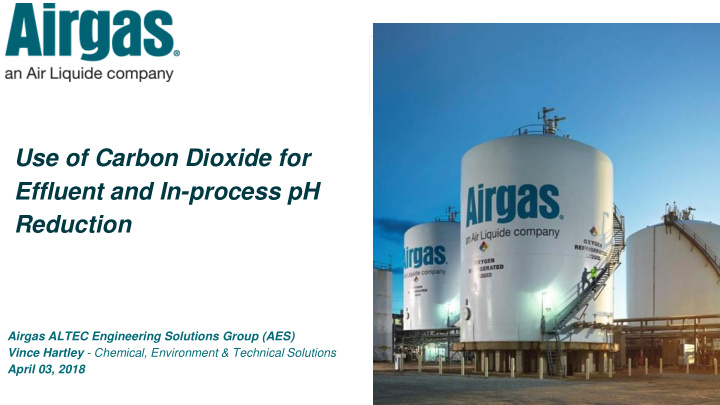



Use of Carbon Dioxide for Effluent and In-process pH Reduction Airgas ALTEC Engineering Solutions Group (AES) Vince Hartley - Chemical, Environment & Technical Solutions I April 03, 2018 INDUSTRIAL MERCHANT
Carbon Dioxide Background CO 2 is a by-product from ● ✓ Steam Reforming H 2 unit (Refineries, Fertilizer plant) ✓ Fermentation Compressed, cleaned, liquefied to 0 o F and 300 psig ● ● Uses ✓ Carbonated beverages ✓ Food Freezing/Chilling ✓ EOR (oil recovery) ✓ Inert food, chemical ✓ Cryogenic chilling plastic industry ✓ Plastic foaming ✓ pH control I INDUSTRIAL MERCHANT
Introduction CO2 Use in Wastewater Treatment ● ✓ Driven by discharge regulations (6 - 9.5) ✓ Across all industries ✓ pH adjustment to optimize coagulant/flocculants Potable Water ● ✓ Recarbonation ■ Stabilization of water after lime softening In-process ● ✓ Chemical reaction ✓ Paper machine, bleach plant ✓ In-situ carbonate formation ✓ Milk I INDUSTRIAL MERCHANT 3
Types of Industries Food & Beverage ● Chemical Plants ● Refineries ● Concrete Facilities ● Dairies ● Steel ● Laundries ● I INDUSTRIAL MERCHANT
CO 2 for pH Control - How does it work? CO 2 is injected into water & reacts to form carbonic acid that instantly reacts with alkalis (caustic soda, sodium carbonate, dissolved lime) transforming them into neutral carbonates & bicarbonates - thus lowering the pH - + H + ⇆ CO 3 2- + 2H + CO 2 + H 2 O ⇆ H 2 CO 3 ⇆ HCO 3 carbonic acid bicarbonate carbonate I INDUSTRIAL MERCHANT
Chemistry of CO 2 pH control Caustic + Carbonic acid = Sodium carbonate: ● ✓ 2NaOH + H 2 CO 3 Na 2 CO 3 + 2 H 2 O (down to pH= 11.6) Sodium carbonate + Carbonic acid = Sodium bicarbonate: ● ✓ Na 2 CO 3 + H 2 CO 3 2 Na(HCO 3 ) 2 (down to pH= 8.3) Each step corresponds to a reduction in pH ● I INDUSTRIAL MERCHANT
CO 2 vs. Acid Benefits ● No unwanted secondary products (chlorides, ● Lowers pH to 6-9 range, (EPA sulfates) requirement for discharge into Less regulatory oversight for storage, ● waterways) transportation, etc. Eliminates possibility of ● Safer (most acids are EHS) ● overshooting pH w/ better control ● Often cheaper than acid ● Will not corrode pipes, tanks, equipment Disadvantages ● Does not lower alkalinity More complex mixing ● I INDUSTRIAL MERCHANT
CO 2 vs. Acid ● CO 2 Advantage ✓ pH Stability (6.0 - 7.0) ✓ no over-acidification I INDUSTRIAL MERCHANT 8
CO 2 vs. Acid Typical Value Model ● ✓ pHi=12 @ 77 o F ■ Sulfuric Acid (93% sol’n) H 2 SO 4 ■ Hydrochloric Acid (32% sol’n) HCl pH f H 2 SO 4 (93%)/CO 2 HCl(32%)/CO 2 lb CO 2 /lb acid lb CO 2 /lb acid 10 0.63 0.30 9 0.80 0.38 8 0.85 0.40 7 1.06 0.50 6.5 1.55 0.72 I INDUSTRIAL MERCHANT 9
Injection ○ Direct PIPE (Gas or Liquid) ■ Porous diffuser ■ Spray Nozzle Sampling valve ■ Static mixer, Flow nozzle, ■ Gas/Liquid ratio Critical Venturi Direct TANK (Gas) ○ Bubble flow regime ■ Porous diffuser ■ Agitator ■ Closed loop Flow nozzle / Jet Ejector Eductor ■ Self-Cleaning injector ■ High Solids ● I INDUSTRIAL MERCHANT 10
pH Control Configuration Dissolution device Treated pH probe Stream Retention time - 30 seconds P T CO2 PIC I INDUSTRIAL MERCHANT 11
pH Control Configuration Treated Stream pH probe Retention time - 120 seconds Dissolution device P T CO2 PIC I INDUSTRIAL MERCHANT 12
Why now? ● Stricter regulations ✓ Limiting discharge of S, Cl or P compounds ✓ Tighter pH limits on permits ● No alkalinity destruction Scarce water resources ● Water re-use/Green push ● ● Potential sequestration I INDUSTRIAL MERCHANT
Up and Coming ● Improvement in CO2 supply ✓ CO2 supply had been dwindling for many years Change in technology ■ Movement of industry to overseas ■ ✓ Ethanol sources Improving technology and research ● ✓ Potential to recover CO2 from stack gases ■ Can be utilized at lower purities ✓ Even from the environment in some extreme cases ✓ Potential to utilize in applications previously too difficult Cooling Towers ■ I INDUSTRIAL MERCHANT
Thank You, Questions? I INDUSTRIAL MERCHANT
Recommend
More recommend